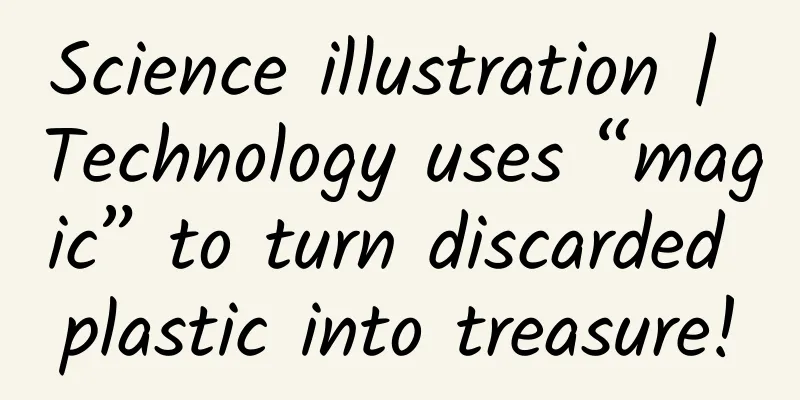It won’t degrade for 450 years. How harmful is it to discard masks carelessly?

|
Produced by: Science Popularization China Produced by: Vivian (Beijing University of Aeronautics and Astronautics) Producer: Computer Network Information Center, Chinese Academy of Sciences As the epidemic rages repeatedly, wearing a mask when going out has become a lifestyle habit to protect others and oneself, but "hidden dangers" also come with it... Masks discarded carelessly may trigger an "environmental protection campaign"! Discarded masks (Photo source: veer photo gallery) Masks are not simple cloth, but plastic products. The mask body of a medical surgical mask consists of two layers of non-woven fabric inside and outside and a layer of meltblown fabric in the middle. The outer layer has an anti-droplet function, the middle layer acts as a filter, and the inner layer mainly absorbs liquids and moisture released by the wearer. Common structures of medical masks (Image source: Reference 1) Both non-woven fabrics and meltblown fabrics are non-woven fabrics. The raw material is special polypropylene resin. The polymer is in a molten state, which is spun into fibers through a specific process and then reinforced by heat bonding or self-bonding. Meltblown cloth is the "heart" of the mask. It is made of polypropylene with a high melt index and finer fibers. Meltblown cloth made of polypropylene fibers with a diameter of 0.1-2 microns has high porosity, good air permeability and low filtration resistance. The meltblown cloth is treated with electret to make the fibers charged. When droplets containing viruses approach the meltblown cloth, they will be electrostatically adsorbed on the surface, thereby achieving the purpose of protection. Meltblown fabric fiber structure (Image source: Reference 2) Discarding masks at random is harmful At present, human society is highly dependent on plastics, and plastic products including polypropylene are everywhere in our lives. It is reported that more than 8 million tons of plastic waste enters the ocean every year, and white pollution is even more common on land. During the fight against the new coronavirus, the use of medical supplies such as masks, protective clothing, and gloves has increased sharply. During the epidemic, it is estimated that 129 billion discarded masks will be generated every month worldwide, based on the estimate that each person uses one mask per day. If masks are discarded in the natural environment at will, it may take hundreds of years to degrade. Not only that, they will also have long-term effects on the environment, animals and even humans themselves. Because of their appearance similar to jellyfish, masks floating in the ocean will be mistakenly eaten by other creatures. In September 2020, a penguin corpse was found on a beach in Brazil, and a mask was found in its stomach after dissection. A penguin with a mask in its stomach (Image source: CGTN) The hazards of plastic pollution go far beyond this. Under the influence of external factors such as light, wave impact, erosion, and weathering, plastic products will be decomposed into microplastics that are so small that the human eye cannot distinguish them. The impact of microplastics on the ecological environment such as the ocean, freshwater, and land should not be underestimated. Microplastics are small but very harmful We used to think that the absence of white plastic bags in the sky and beverage bottles on the water was proof of our success in combating plastic pollution. As we gain a deeper understanding of plastic pollution, the invisible harms are gradually coming to light. Microplastics in the water will be ingested by zooplankton and then enter the body of fish through the food chain, causing them to develop slowly and behave abnormally. Humans, who are at the top of the food chain, will further accumulate microplastics in their bodies after eating animals containing microplastics. Fish eat plastic waste, and people eat fish, forming bioaccumulation (Image source: Theoceancleanup) The distribution of microplastics in the environment may be far more widespread than we imagined. In 2019, scholars from the Scripps Institution of Oceanography in the United States analyzed the core of seabed sediments about 580 meters deep off the coast of Santa Barbara and found a large number of microplastics, including fibers, fragments, and particles. Plastic pollutants in seafloor sediments (Image source: Reference 5) Researchers from the Canadian Ocean Conservancy and the University of British Columbia have also found polyester microplastic fibers in the Arctic, with large quantities entering the Arctic via the North Atlantic. Whether it’s microplastic fibers discharged directly from textile and laundry wastewater, or microplastics that are broken down by the environment as they travel along ocean currents, their intrusion into the Arctic is already obvious. The accumulation of microplastics in the Arctic Ocean (Image source: Reference 6) Microplastics on Mount Everest (Image source: Reference 7) The ability of microplastics to enter the air and land has already astonished us, and a recent study on the absorption of microplastics by crops is even more astonishing. The research team of the Yantai Institute of Coastal Zone Research of the Chinese Academy of Sciences found that the roots, stems and leaves of wheat and lettuce, which are model crops, all contain microplastic components absorbed from wastewater. The pores in the plant epidermis are relatively large, so microplastics cannot easily enter. However, there are some inconspicuous slits on the edges of the new lateral roots of the plant, which are the entrances for microplastics to enter the plant. Then, driven by transpiration, microplastic particles are transported from the roots to the buds. Studies have shown that about 50% of the world's population has microplastics in their bodies, and microplastics can be ingested by the body through breathing, drinking, and eating. Although the impact of microplastics on human health is still unclear, the problem of microplastic pollution is already imminent. Don't be afraid, there are always more solutions than problems. Where there is a problem, there is a solution. People found ways to use plastic instead of ivory to protect elephants from being hunted. Today, as plastic pollution becomes more and more serious, we are also constantly looking for solutions. In the face of increasingly serious plastic pollution, technology has provided new possibilities for environmental protection. In response to the problem of meltblown fabrics for masks, researchers designed and synthesized biodegradable modified poly (butylene adipate/terephthalate) meltblown materials. The new material can not only ensure the filtering effect, but also reduce the pollution of discarded masks to the environment. In addition, researchers have also found natural enemies of plastics in nature, such as bacteria (Ideonella sakaiensis) that can digest polyethylene terephthalate (PET), Aspergillus tubingensis that helps degrade polyurethane (PU), and waxworms (Indian meal moth larvae) that chew and eat polyethylene (PE) films. Waxworms that can eat polyethylene film (Image source: Reference 9) Recently, researchers from the University of Barcelona in Spain published a study in Scientific Reports that proposed that seagrass meadows could be used to remove plastic waste from the ocean. As a temperate species, seagrass (P. oceanica) sheds its leaves in autumn, and its leaf sheaths and other debris accumulate on nearby beaches. The wood fibers contained in the leaf sheaths are entangled into balls, called seagrass fiber balls, which can capture plastic pollutants and bring them to the shore. As many as 1,470 plastic items were found in each kilogram of seagrass fiber balls, and it is estimated that the fiber balls in the Mediterranean seagrass meadows can capture 867 million plastic pollutants each year. Although the plastic pollutants brought to the shore by seaweed balls still require a lot of processing investment, they have helped solve many problems. Plastic fibers collected by seaweed balls (Image source: Reference 10) Although the current situation of microplastic pollution is severe, both humans and nature are fighting against it with a positive attitude. There are many small changes we can make, from using less plastic bags to properly disposing of masks, from correctly understanding microplastics to having a positive attitude without panic. While it’s difficult to completely eliminate plastic products, we can dispose of them in a more environmentally friendly way. References: 1. Research progress of filter materials for medical masks. 2. Application of polypropylene materials in medical masks. 3. Lost at Sea: Where Is All the Plastic? https://science.sciencemag.org/content/304/5672/838 4. https://theoceancleanup.com/great-pacific-garbage-patch/ 5. Multidecadal increase in plastic particles in coastal ocean sediments. https://advances.sciencemag.org/content/5/9/eaax0587. 6. Pervasive distribution of polyester fibers in the Arctic Ocean is driven by Atlantic inputs. https://doi.org/10.1038/s41467-020-20347-1. 7. Reaching New Heights in Plastic Pollution—Preliminary Findings of Microplastics on Mount Everest. https://doi.org/10.1016/j.oneear.2020.10.020 8. Effective uptake of submicrometre plastics by crop plants via a crack-entry mode. https://doi.org/10.1038/s41893-020-0567-9. 9. Evidence of polyethylene biodegradation by bacterial strains from the guts of plastic-eating waxworms. https://pubs.acs.org/doi/abs/10.1021/es504038a 10. Seagrasses provide a novel ecosystem service by trapping marine plastics. https://doi.org/10.1038/s41598-020-79370-3. |
<<: There are so many banks, why can't they merge into one?
Recommend
How to use ADB, the Android development debugging tool
ADB (Android Debug Bridge) is a tool in the Andro...
A collection of features of 17 mainstream online marketing and promotion channels!
We have sorted out 17 mainstream online marketing...
ACEA: European new car registrations in September 2020 reached 1.3 million, up 1.1% year-on-year
Data released by the European Automobile Manufact...
Is virtual reality the next 3D TV?
Many seemingly wonderful technologies always fall...
4 tips to teach you how to use Xiaoguan Tea's marketing methods to create a hot-selling community
Do you think that Xiaoguan Tea became popular all...
Who will be killed in a traffic accident involving a self-driving car?
According to Business Insider, experts say self-d...
What does "starting with an egg" mean? This is called native advertising!
When doing information flow advertising , the mos...
Samsung, LG and other Korean battery manufacturers increase investment in China: targeting the new energy vehicle industry
According to BusinessKorea Beijing time on May 5,...
Quantitative Science Lecture Hall Jincheng Li Yamin Quantitative Science Capture Dragon Ambush Dragon Head 32nd Video + Closing Review
: : : : : : : : : : : : : : : : : : : : : : : : : ...
1600 words to explain: How to acquire customers at low cost?
What are the three important factors that affect ...
What is the difference between an ice cream that costs a few yuan and one that costs more than ten yuan?
Expert of this article: Pa Lize, Chief Physician ...
How can a novice quickly build an information flow account? Teach you how to do it in 3 steps!
Many optimizers who have just started to work on ...
Tencent practical case! How does QQ Sports upgrade user experience?
In this era of national fitness, more and more us...
Didi sheds tears for Da Vinci, the 150,000 yuan price range of the MONA model may help Xiaopeng Motors surpass NIO
After more than two years of planning, Didi final...
Illustration | The giant panda "Ya Ya" who traveled to the United States is on her way back to China! Let's take a look at her eating, drinking, defecating and urinating along the way
Yaya is going back to China! Taking a special pla...









